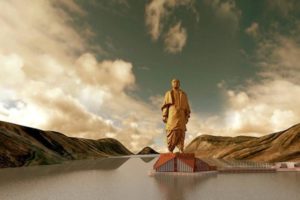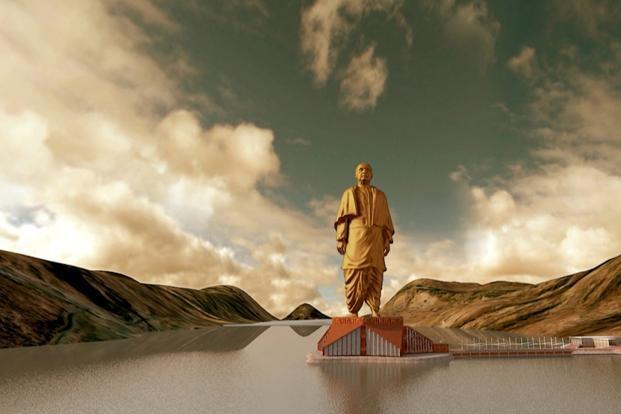Sardar Vallabh Bhai Patel was one of the important social and political leaders of India. He played an important role in India’s struggle for freedom. He is believed to be born on 31 October 1875 at Nadiad, Gujarat and was often addressed as Sardar.
He did his matriculation at the age of 22. He seemed to be an ordinary person to everyone around him, but had strong will power. He wanted to become a barrister. At the age of 36, he went to England to fulfill his dream and joined Middle Temple Inn. He completed his 36-month course in just 30 months. After returning to India he became one of the most successful barristers of Ahmedabad.
Inspired by the work and philosophy of Mahatma Gandhi, he joined India’s struggle for independence. He organised peasants of Kheda, Bardoli and other parts of Gujarat and launched non-violent Civil Disobedience Movement in Gujarat, against the payment of raised tax, levied by the British government. He succeeded in his goal and the British Government suspended the payment of revenue for that year. With this he became one of the most influential leaders in Gujarat. In 1920 he became the president of Gujarat Pradesh Congress Committee and served in the post till 1945. He was a strong supporter of the Non -Cooperation Movement of Gandhi and worked against alcoholism, Untouchability and caste discrimination in Gujarat. He was elected as the municipal president of Ahmedabad in 1922, 1924 and 1927. When Mahatma Gandhi was in prison, he led the Satyagraha in Nagpur in 1923 against the British law, banning the raising of the Indian flag. He was elected as the President of India National Congress in 1931. He was at the forefront of the Congress’ all India election campaign in 1934 and 1937 and was a prominent leader in organising the Quit India Movement in 1942. He was arrested prior to the Quit India Movement and was released in 1945.
After India’s independence, he became the first Home Minister and Deputy Prime Minister of India. He organised relief camps for refugees in Punjab and Delhi. He was the man behind the consolidation of 565 semi-autonomous princely states to form a united India. Patel was very attached to Mahatma Gandhi. After Mahatma Gandhi’s death his condition also started deteriorating, he suffered a major heart attack within two months of Gandhi’s death. He died on 15 December 1950. He was a man of courage and determination and in the true sense the ‘Iron Man of India’.
Born October 31, 1875 (Nadiad) Died December 15, 1950 (Bombay) Father Jhaverbhai (farmer) Mother Laad Bai Wife Jhaverba Elder Brothers Somabhai, Narsibhai and Vithalbhai Patel. Younger Brother Kashibhai Sister Dahiba Son Dahyabhai Daughter Maniben Leaving Home After contracting Bubonic Plague, he started leaving alone in Nadiad and recuperated slowly. Wife’s Cancer Patel’s wife was a patient of cancer. She died during a major surgical operation. Early Political Career In September 1917, Patel delivered an encouraging speech in Borsad to motivate Indians to sign Gandhi’s petition demanding Swaraj.Patel also rose against the forced servitude of Indians to Europeans. He organised relief efforts at the time of plague and famine in the Kheda district.
Vallabhbhai Patel initiated a village-to-village tour to involve maximum people in the statewide revolt to refuse the payment of taxes.
Patel supported Gandhi’s Non-cooperation Movement and toured the state to recruit more than 300,000 members and raise over Rs. 15 lakh in funds.
Satyagraha was led by Patel in Nagpur in the absence of Gandhi in 1923 against a law that restricted the hoisting of the Indian flag.
The Sardar Patel became popular as Sardar among his colleagues and followers after the triumph in Bardoli.Patel became the Congress president for the Karachi session of 1931.
Quit India Movement On the outbreak of World War II, Patel supported Nehru’s decision to withdraw the Congress from central and provincial legislatures.In 1940 he was jailed for 9 months .
In 1942 he rejected the proposals of the Cripps’ mission.
Integration after Independence In the 1946 election for the Congress presidency, Patel stepped down in favour of Nehru.As the first Home Minister, Patel’s role was significant in integration of several princely states into the Indian federation.
Vallabhbhai Patel believed that the partition of India could resolve the rising Muslim separatist movement led by Muhammad Ali Jinnah.
Patel represented India on the Partition Council and chose the Indian council of ministers with Nehru.
Leading India Patel took the decision to appoint Dr. Bhimrao Ramji Ambedkar as the chairman of the drafting committee and the other leaders for the process of writing the constitution.Patel was the chairman of the committees that was responsible for fundamental rights, tribal and excluded areas, minorities and provincial constitutions.
When the Pakistani invasion of Kashmir began in September 1947, Patel immediately wanted to send troops into Kashmir. But agreeing with Nehru and Mountbatten, he waited till Kashmir’s monarch had acceded to India. Patel then oversaw India’s military operations to secure Srinagar, the Baramulla Pass and the forces retrieved much territory from the invaders.
Gandhi’s death and relations with Nehru Patel was a loyal follower of Gandhi.Nehru and Patel argued over national issues. Nehru was opposed by Patel over his Kashmir policy. According to Patel, Nehru was not justified in sidelining his home ministry’s officials.
 New Delhi: An engineering marvel completed in a record time of 33 months, the world’s tallest statue—Sardar Patel’s statue or the Statue of Unity—will be inaugurated during a gala function on Sardar Vallabhbhai Patel’s birth anniversary on 31 October. Prime Minister Narendra Modi, who had laid the foundation stone for the project on 31 October 2013, will also be the one to inaugurate it on Wednesday.
New Delhi: An engineering marvel completed in a record time of 33 months, the world’s tallest statue—Sardar Patel’s statue or the Statue of Unity—will be inaugurated during a gala function on Sardar Vallabhbhai Patel’s birth anniversary on 31 October. Prime Minister Narendra Modi, who had laid the foundation stone for the project on 31 October 2013, will also be the one to inaugurate it on Wednesday.
Double the height of the Statue of Liberty in New York, the Sardar Patel statue near the Narmada Dam in Gujarat is not only the tallest in the world but also the one to be completed in the shortest time. The 182-metre Statue of Unity took 33 months to complete while China’s Spring Temple Buddha statue took 11 years.
Here is a list of 10 interesting features of the Sardar Patel statue in Gujarat:
1. Built by Larsen & Toubro Ltd at a cost of ₹2,989 crore, the Statue of Unity is made up of 1,700 tonnes of bronze and 1,850 tonnes of bronze cladding on the exterior. The interior is filled with concrete cement (180,000 cubic metres), reinforced steel (18,500 tonnes) and structured steel (6,500 tonnes).
2. If you are about 5.6 feet tall, the giant State of Unity is 100 times larger than you.
3. There are two high-speed passenger elevators in the statue’s core which take you up to the chest of the statue to a viewing gallery, which can accommodate 200 tourists at a time. This is also the best place to get a bird’s eye view of the picturesque environs of the Narmada river and its dam surrounded by the Satpura and Vindhyachal hills.

4. With a three-star hotel, museum and audio visual gallery, the government has tried to build an entire ecosystem of tourism infrastructure centered on the statue in the remote, hilly terrain.
5. The construction of the Sardar Patel statue has had its own engineering challenges, not just due to its height but also because of its location in the middle of the Narmada river and the walking pose of Sardar Vallabhai Patel. The statue is designed to withstand winds of almost 180km/hour and earthquakes measuring 6.5 on the Richter scale.
6. Noida-based sculptor Ram V. Sutar, who designed the statue, took special care to ensure that the statue’s face resembles Patel’s facial features. For the process, around 2,000 photographs from archives were studied. Historians and people who had seen the “Iron Man” were also consulted. From a distance, it appears as if Sardar Patel is walking on water towards the Sardar Sarovar dam.
7. The Gujarat government is also building a 3.5km long highway for tourists to reach the statue from Kevadia town.
8. A 320-metre-long designer bridge connects Sadhu island to the mainland. You can also take a boat ride.
9. Around 135 metric tonnes of iron were crowdsourced from lakhs of villages all over India for use in the project.
10. Clicking images at the statue site will be easier with a selfie point that has a good vantage point for photography.
In Depth : Statue of Unity – Rajya Sabha TV (Govt. of India)
Source:mapsofindia
Image Courtesy:E.T/Livemint
You may also like
-
India Can’t Afford to Remain Stagnant at this Juncture, Says PM Modi; Asks People to Buy Locally-Made Goods
-
Stolen Artefacts to be Returned to India from Scotland Museums
-
Legendary Singer Lata Mangeshkar Passes Away At the Age of 92
-
Netaji’s Hologram Statue at India Gate
-
10th Century Stone Idol of Goat Head Yogini IllegallyRemoved from A Temple in Lokhari, Banda, UP Being Returned to India
